2022 Pharm Exec Top 50 Companies
The windfall from COVID-19 vaccines and treatments has shaken up Pharm Exec’s latest listing of the top global biopharma sales producers in record-breaking fashion, but a likely leveling off—along with challenging patent and global climates—should shift some of the spotlight to anticipated non-COVID risers and perhaps more definitive maneuvering ahead.
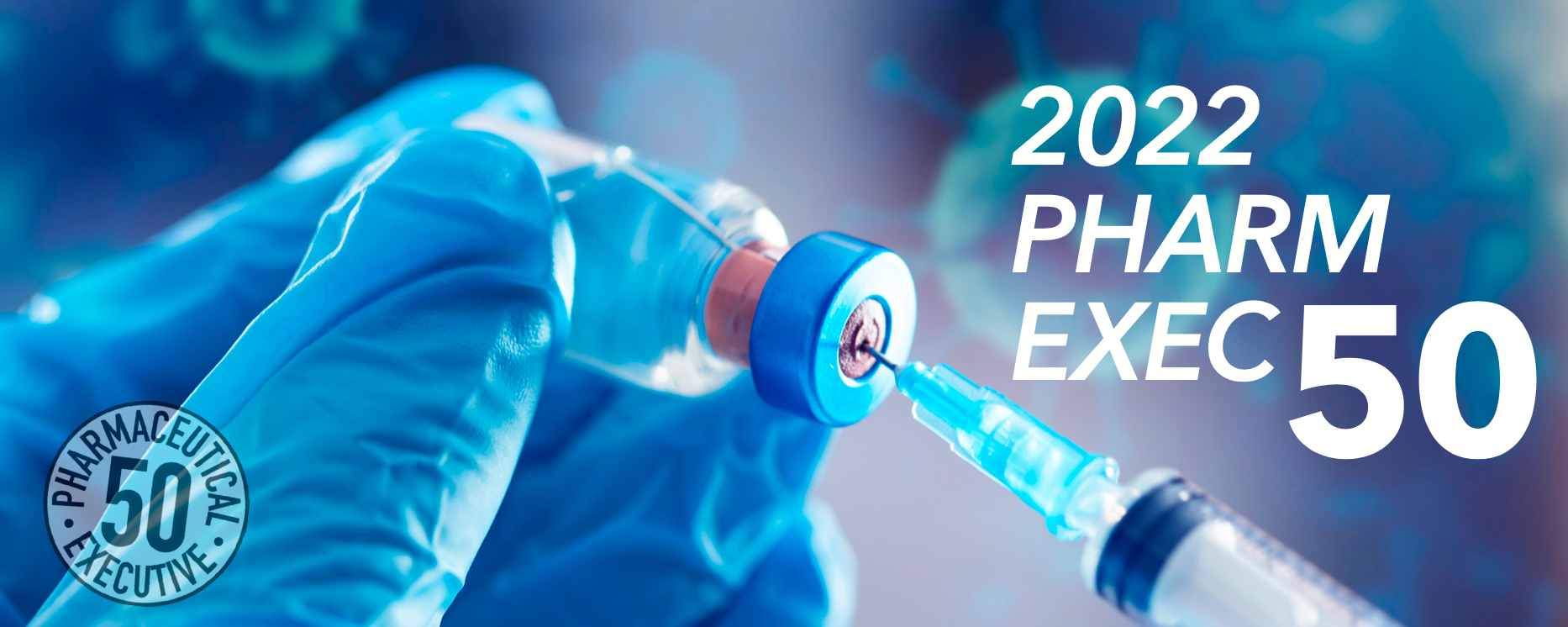
If 2020 was the “Year of COVID,” as we referred to it in our Pharm Exec 50 feature last year—reflecting on the pandemic’s scope and disruption on all facets of life—then 2021 was surely the year of COVID vaccines and treatments. And, through the prism of our latest rankings of the top 50 global biopharma players based on prescription drug sales, one that will go down in the annals of commercial Rx output—even if just a short burst in time when looked back upon decades from now. To illustrate the pandemic’s historic jolt to our annual listing, rearranging several spots in the top half, attention first goes to mRNA vaccine makers Pfizer and Moderna, with the former also delivering significant recent gains from its effective, if not somewhat controversial, antiviral therapy for COVID. In data again provided in partnership with Evaluate Ltd, the rankings, our 22nd, capture most recent full-year drug revenue performance. Company R&D investment totals are also presented, as in previous installments.
Last year, Pfizer recorded overall prescription drug sales of $72 billion, with $37 billion of that generated from COVID vaccine Comirnaty, alone, making it the best-selling drug in a single year of all time by a wide margin. Factor in first-quarter revenue of $13.2 billion for Comirnaty in 2022, and the vaccine, developed in partnership with German biotech BioNTech, is already rivaling the cumulative lifetime sales of many blockbuster medicines. Paxlovid, Pfizer’s COVID pill, which received FDA emergency use authorization in December 2021, posted $1.5 billion in first-quarter sales and may be poised to become the best-selling non-vaccine ever, if it lives up to Pfizer’s projected guidance of $22 billion for 2022 (the company says it is set to produce 120 million treatment courses this year, and according to published reports, it doesn’t have to sell all of those courses to exceed $22 billion). If the ramped-up manufacturing and totals comes to fruition, Paxlovid would eclipse AbbVie’s Humira’s $20.7 billion in sales in 2021 as the highest grossing non-vaccine to date. Those prospects have encountered recent headwinds, including the CDC’s warning of a potential COVID “rebound” after taking Paxlovid.
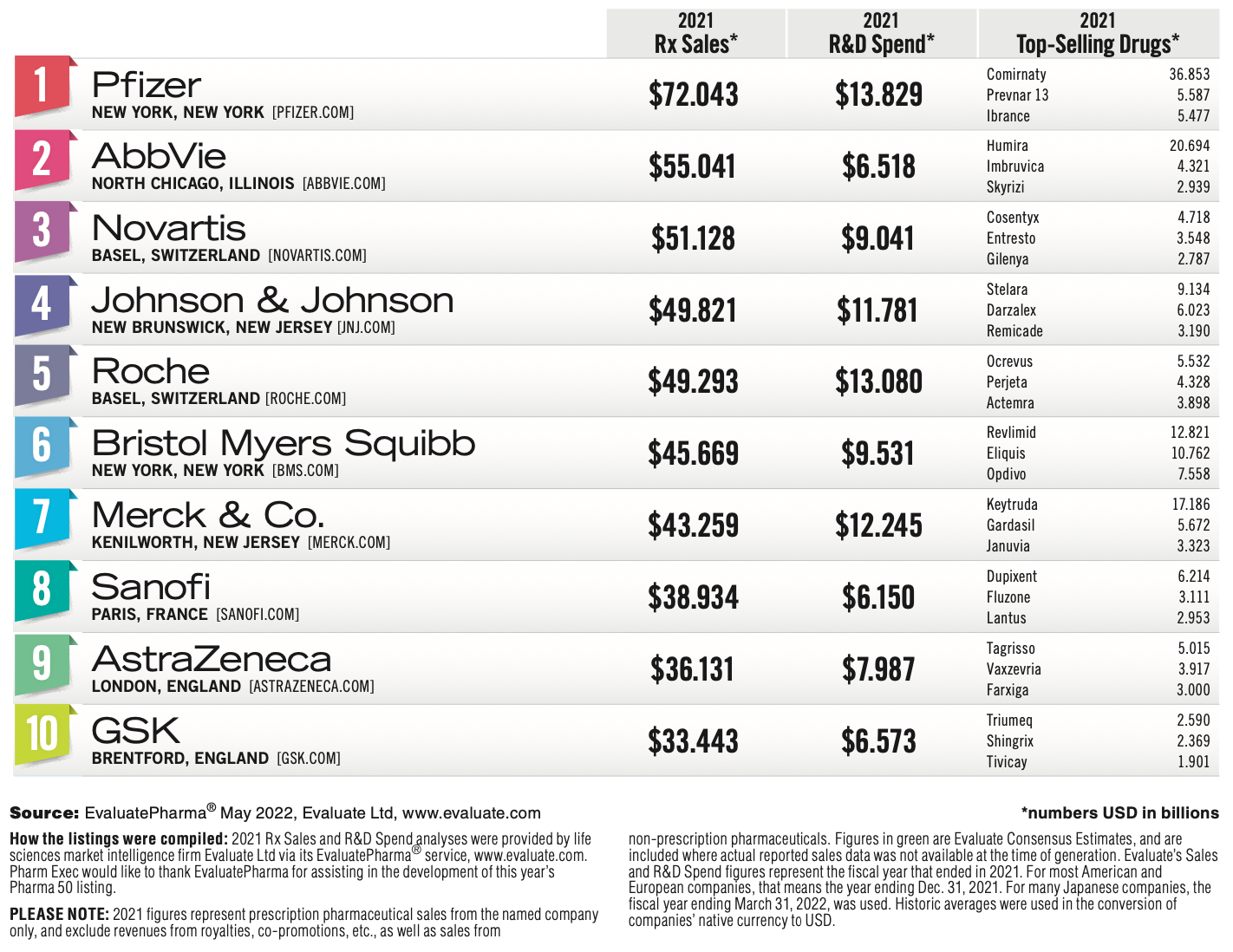
Big gains, but will they sustain?
Pfizer and Moderna are among a handful of biopharmas that have reaped the rewards of the COVID windfall following successful development projects. Given the aforementioned numbers, it was no surprise that Pfizer vaulted from the eighth spot in our previous company rankings to No. 1 in the newest ledger, posting an increase in Rx sales of 102%. In fact, Comirnaty’s output by itself would rank Pfizer ninth overall. In May, the pharma giant reported the best quarter in the company’s history, with total revenue (not just Rx) of $25.6 billion; it expects full-year 2022 revenue between $98 billion and $102 billion (although Pfizer did cut its earnings per share slightly for the year in adjusted first-quarter guidance).
Sharing the mRNA-platform stage in COVID has been Moderna’s vaccine Spikevax, which propelled the Cambridge, Mass.-based biotech into the Pharma 50 for the first time behind $17.7 billion in 2021 sales. Moderna secured the 17th spot with $19.2 billion in total Rx revenue. The company sold $5.9 billion of its COVID vaccine in the first quarter of this year, and in its May earnings call maintained the organization’s full-year guidance of $21 billion in Spikevax sales. Of note recently, the marketing authorization for Spikevax in Japan will transfer from Takeda to Moderna starting Aug. 1, the two companies announced in late May.
Driven by its monoclonal antibody treatment, REGEN-COV (Ronapreve), for preventing COVID symptoms, Regeneron leapfrogged eight spots in the Pharma 50 to No. 20, with an increase of 118% to $12.1 billion in prescription drug sales. REGEN-COV, which was effective against initial COVID variants, posted $5.8 billion in 2021 sales.
Other notable pandemic-influenced jumps in our rankings include AstraZeneca (AZ), whose vaccine Vaxzevria reached $4 billion in sales last year, helping catapult the company to a 41.5% increase in Rx sales and two spots up to No. 9; Gilead Sciences advancing one spot to No. 12 (and a spike of 13.4%) behind its antiviral drug Veklury (remdesivir), which recorded $5.6 billion in revenue; and Johnson & Johnson (J&J), which generated $49.8 billion in 2021 Rx sales, securing fourth on our list and an increase of 15.5% from the previous year. The company’s COVID vaccine, marketed by its Janssen unit, made $2.39 billion in 2021.
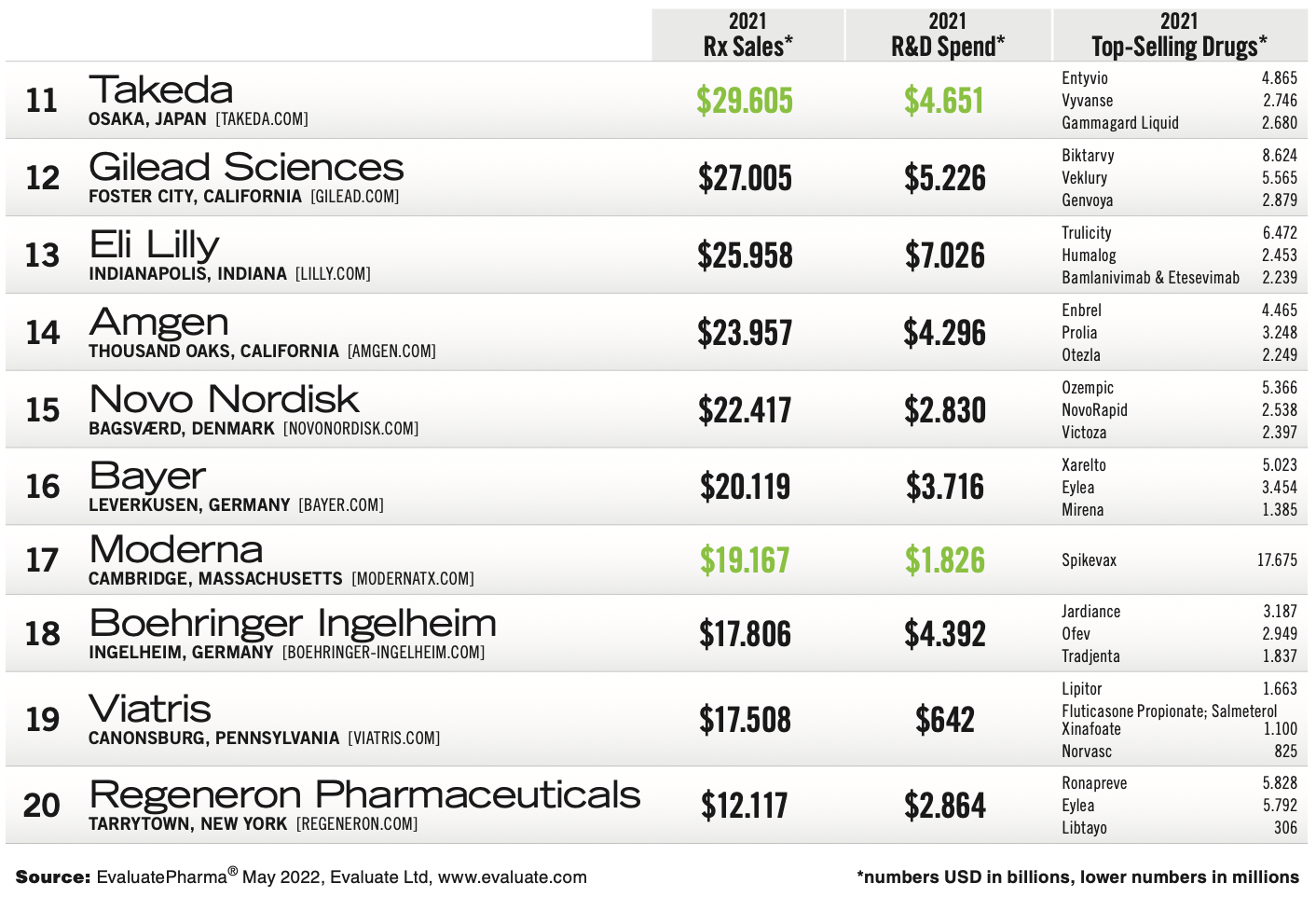
Perhaps factoring into our rankings next year will be treatments or vaccines cleared for emergency use or expanded use in the US and/or Europe in late 2021/early 2022 from Eli Lilly, Merck, GSK, and Sanofi. (For example, revenue from Lilly’s COVID antibodies, bamlanivimab and etesevimab, grew $660 million in the first quarter of this year; the duo made $2.2 billion in 2021, and Merck’s oral antiviral molnupiravir posted $3.2 billion in Q1).
The million-dollar (or billion-dollar) question is just how long will these tenacious tailwinds last. The consensus among analysts is that first-cleared products during the pandemic may have already hit their peaks, or will this year, and sales will likely start to dip from there. But proper context should also be weighed in the equation—after all, the pandemic has represented an extremely special and unforeseen circumstance for the life sciences and healthcare sectors, one that triggered an unprecedented response in R&D and ultimately product distribution and delivery; thus comparing the sales of COVID products to other drugs in the traditional sense may not be a fair exercise.
Potential new records after this year, nevertheless, are unlikely in the near future. Editors at Evaluate Vantage interviewed by Pharm Exec cite trends such as waning demand for COVID vaccines and drugs, as well as supply challenges and shifts in where future government contracts will predominately originate. “I think most of the developed Western worlds that are able to pay higher prices have already bought their vaccine stockpiles,” says Lisa Urquhart, editor, Evaluate Vantage, who is based in London. “There’s debate [in the UK] on whether or not there’s going to be the need for a fourth vaccine [dose] outside of the immunocompromised and the vulnerable. If the US follows suit and if new strains continue the trend of being more mild, then I think some of the targets around the sales might not materialize. It also means you’re now going to have to start selling outside of the Western world into emerging markets where your margins are going to be much lower.”
The consensus for Comirnaty sales in 2023 is reportedly around $17 billion. Evaluate projects revenue for Comirnaty and Paxlovid settling between $2 billion to $4 billion, respectively, by 2025. In the more immediate setting for Paxlovid, Urquhart points to uncertainties around the number of new contracts signed in the first quarter and how much ground will be needed to make up to meet Pfizer’s $22 billion full-year target. She also notes the fairly strict use of Paxlovid, with several contraindications, such as with patients with diabetes and hypertension. Consensus for Moderna’s Spikevax, Evaluate says, is around $2 billion in annual sales by 2026. The company’s post-COVID strategy will be followed closely (Moderna’s pipeline includes a candidate in Phase III trials for respiratory syncytial virus, along with early stage projects for the flu and cancer, and next-generation pursuits in COVID).
AZ executives earlier this year projected a low-to-mid 20s drop for Vaxzevria in 2022 (though the company is active in new R&D antibody pursuits), and in April, J&J reported first-quarter sales of $457 million for its vaccine, far short of Wall Street’s estimate. The results, attributed to low demand and an oversupply in low-income countries, prompted J&J to pull the vaccine from its revenue projections. Regeneron posted no US sales in the first quarter for REGEN-COV after FDA rescinded its authorization in January due to poor performance against omicron. Roche, which markets the drug outside the US in a profit-sharing deal with Regeneron, did report $636 million in revenue during the period.
Add to the mix ongoing macroeconomic challenges to navigate, such as the war in Ukraine, supply chain issues caused by China, and global inflation; a volatile M&A and seller valuation climate that has shown little sign of abating; and an impeding “patent winter,” which analysts contend will be the most painful period of branded sales erosion in at least 30 years, and the overall picture for the Pharma 50 could turn a bit unsettled as the decade progresses.
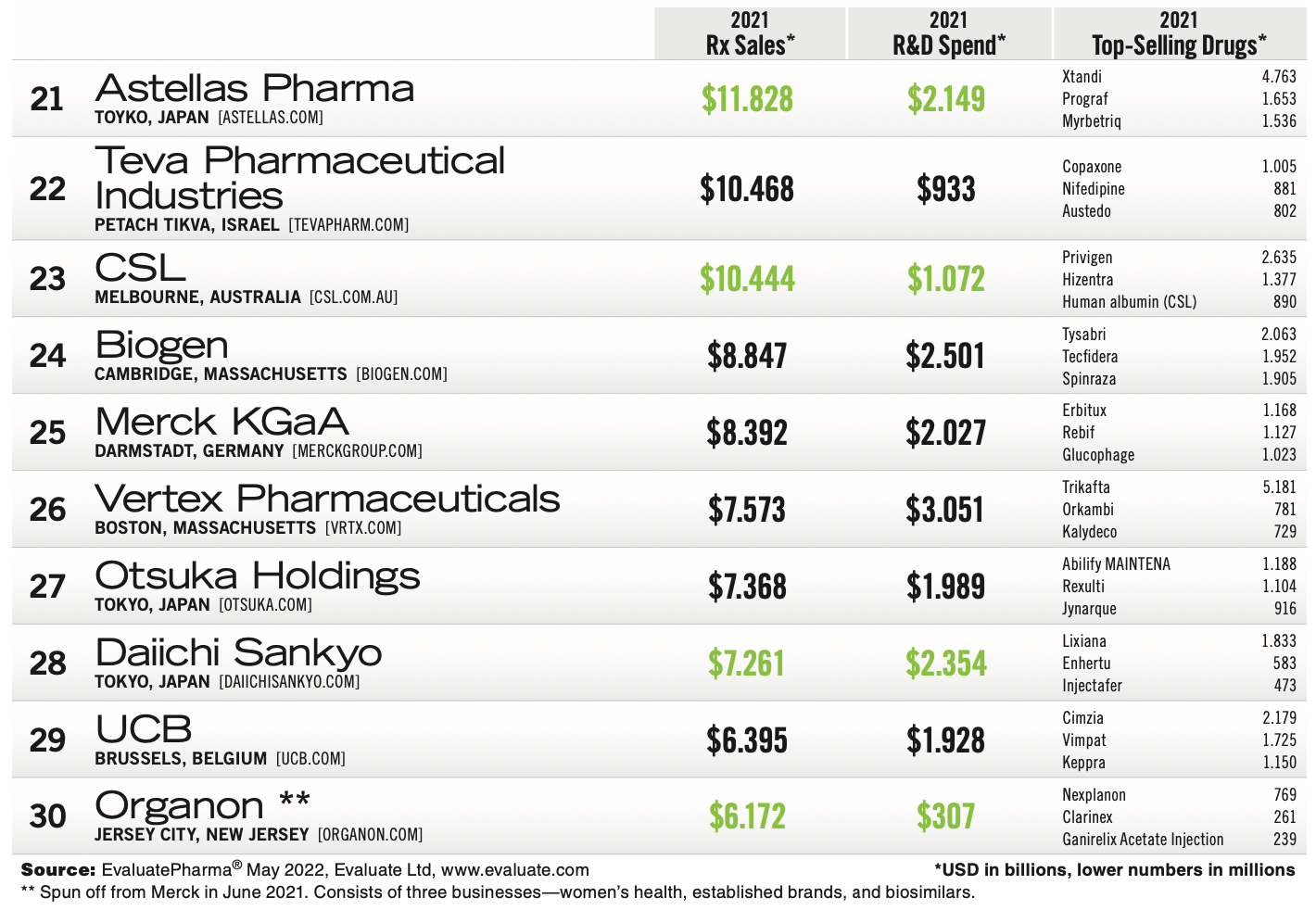
AbbVie’s ascent
Spurred by COVID vaccines and therapies, US spending on pharmaceuticals rose 12% last year, according to a report by the IQVIA Institute for Human Data Science, and the rate of new prescriptions for chronic and acute care largely recovered from the 2020 pandemic-sparked slowdown. To that end, several organizations with no COVID products in our rankings delivered solid gains in 2021 Rx sales, none more than the strong surge made by AbbVie. Prescription drug revenue for the North Chicago-based pharma skyrocketed almost $11 billion to $55 billion last year, moving AbbVie up one spot to No. 2 behind Pfizer. As mentioned, Humira, the company’s flagship, brought in record sales, a number it may eclipse this year before the anti-inflammatory stalwart goes off patent in the US in 2023 and biosimilar competition begins (the majority of Humira’s sales come from the US; it is already off patent in Europe).
While Humira will no longer enjoy $20 billion-plus totals after 2023, Urquhart doesn’t believe sales will fall dramatically in the US like they have in Europe, due to a different reimbursement structure in the US, the greater reluctance of physicians in America to substitute biosimilars for the branded product, and the “patent thicket”-type deals originator companies sometimes enter into.
Combined with Humira follow-ups Skyrizi (IL-23 inhibitor for psoriasis) and Rinvoq (JAK inhibitor)—each enjoying stellar sales climbs since their launches in 2019, the latter continuing to add key new indications and recently showing late-stage promise in Crohn’s disease—along with the steady rise of leukemia drug Venclexta, analysts remain bullish on continued AbbVie momentum. In fact, according to extended consensus forecasts collected by Evaluate, AbbVie is expected to become the biggest pharma company by Rx sales in 2028. Roche is projected to be a close second, followed by J&J (which is spinning off its consumer health business next year to focus more on its branded Rx), Merck, and Pfizer.
Amy Brown, Evaluate Vantage’s special reports and projects editor, tells Pharm Exec that the tandem of Skyrizi and Rinvoq, together, are expected to bring in $18 billion by 2026. “Rinvoq’s recent approval in atopic dermatitis was a big one,” says Brown. It was cleared by FDA in January for patients 12 and older with refractory, moderate-to-severe disease who do not respond to oral drugs.
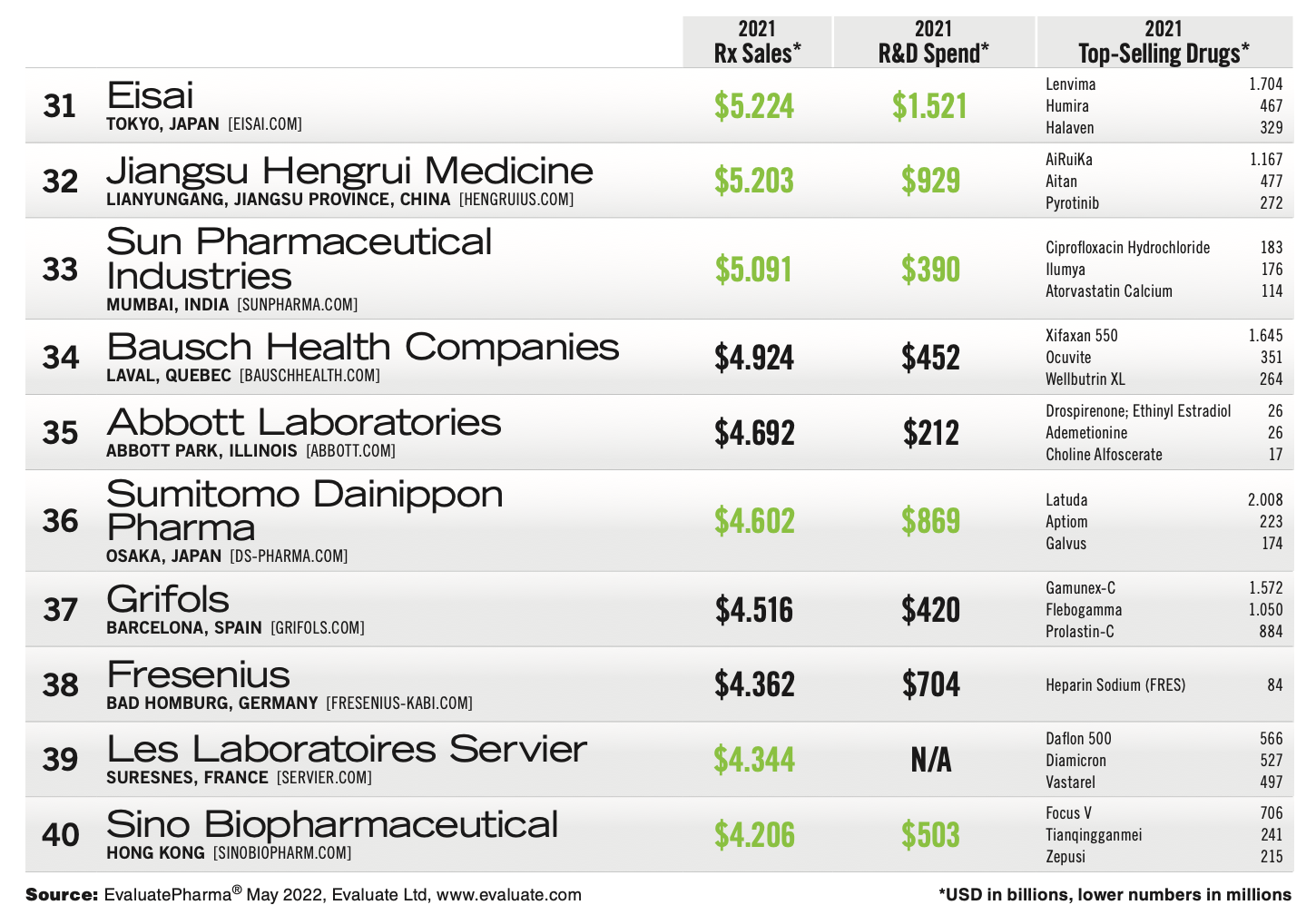
Rounding out the first five spots in our list are Novartis at No. 3, up 8.3% to $51.1 billion; J&J, as mentioned; and Roche, dropping from the top perch to No. 5, posting a 3.8% increase to $49.3 billion. Roche, the leader in R&D spend the last two years, remained strong in that area, investing $13.1 billion, trailing only Pfizer’s $13.8 billion. Merck and J&J also eclipsed double-digits in R&D spend, at $12.2 billion and $11.8 billion, respectively; Bristol Myers Squibb (BMS) was close at $9.5 billion and Novartis invested $9 billion. Driven by pandemic investments, the 11 largest Big Pharma companies saw their combined R&D investments jump 11% in 2021, exceeding $100 billion, collectively, for the first time, according to Evaluate.
On the commercial side, J&J and Roche face notable patent expirations in the coming years—Stelara ($9.1 billion in 2021 sales) next year and Ocrevus ($5.5 billion) in 2029, respectively. Roche’s new drug for wet age-related macular degeneration and diabetic macular oedema, Vabysmo, approved by FDA in January, has projected sales of $1.8 billion from Evaluate in 2026. In partnership with PTC Therapeutics, Roche also gained a key label extension in May for its spinal muscular atrophy drug Evrysdi, now cleared for use across all ages. Novartis made news in April with plans to restructure its global operations, combining the company’s pharma and oncology units. The move pushed out three c-suite executives and signaled looming layoffs, but was done to boost Novartis’ presence in the US market. Quarterly sales for its heart drug Entresto rose 42% to $1.1 billion.
The rest of the Pharma 50 top 10, with each one rising or dropping a spot or two, include BMS at No. 6; Merck at No, 7, Sanofi at No. 8; AZ, as mentioned, taking the ninth spot, and GSK at No. 10. Each posted Rx sales increases year-over-year. Of that bunch, BMS is under the most pressure to maintain, with three blockbuster products facing the patent ax—Revlimid (a former Celgene product) this year, Eliquis in 2026, and cancer PD-1 immunotherapy Opdivo in 2028. Merck’s PD-1 standout Keytruda, which posted $17.2 billion in Rx sales in 2021 and has amassed numerous indications, will lose patent exclusivity in 2028, and its patent for diabetes power Januvia is set to expire next month. Potentially offsetting looming patent loses for BMS could be Camzyos, approved in the US in April as the first drug to treat an inherited form of heart failure known as obstructive hypertrophic cardiomyopathy.
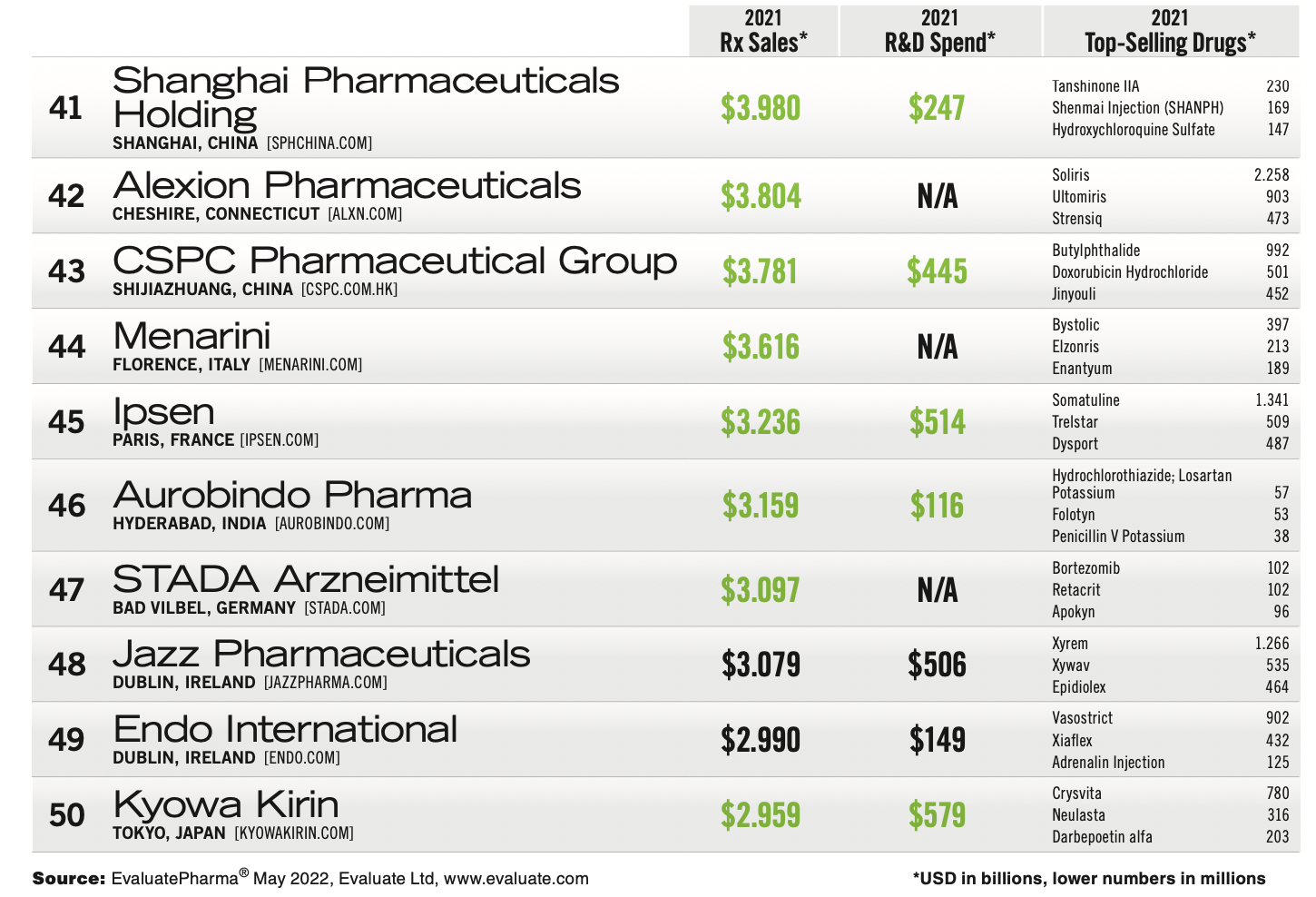
Like Novartis, Sanofi and GSK are in the midst of restructuring efforts, with Sanofi focused on pruning its general medicines pipeline, and GSK the spinoff of its consumer health business into an independent company, called Haleon, set to officially launch next month. The new company is the result of GSK and Pfizer combining their consumer health units in 2019. According to published reports, Pfizer intends to exit its 32% stake in Haleon, triggering a $16 billion inflow of cash. In late May, GSK agreed to acquire clinical-stage biopharma Affinivax for up to $3.3 billion. The deal will add novel pneumococcal vaccine candidates to GSK’s pipeline and support the development of its vaccines and specialty drugs.
Among other top 20 entrants in the Pharma 50, Lilly rose one spot to 13th, with a 15% spike in Rx sales (last month the company won an anticipated approval for its new diabetes drug, Mounjaro, which should rival co-GLP-1 receptor agonist Wegovy, made by Novo Nordisk, and has strong potential in obesity); and Takeda, though down a peg to 11th, posted a 6.1% jump in Rx sales. Two of its top sellers, Vyvanse and Gammagard liquid, were borne out of acquisitions, reflecting Takeda’s pro-M&A slant, Urquhart says, compared to traditional views of Japanese companies on offshore dealmaking, perhaps attributed to Takeda’s French-born CEO, Christophe Weber, who has lead the company since 2015.
Clouded M&A picture
The slowdown of biopharma M&A has continued through the first half of 2022, with the exception (as of press time), on the semi-large scale, of Pfizer agreeing last month to buy Biohaven Pharmaceuticals for $11.6 billion. The prospects of a major Pharma 50 reshuffling via M&A are likely slim for the rest of the year, though cash-rich drugmakers could theoretically pull the trigger if biotech valuations improve. Buyers and sellers, for now, seem to be entrenched in a wait-and-see approach, experts say—with both sides perhaps holding more closely to the principle of “cash is king.”
“Two or three of the Big Pharma CEOs at the last quarterlies said, ‘you know, sellers’ valuations in their heads haven’t changed yet,’” says Brown. “Sellers’ expectations need to reset. In the meantime, I think a lot of these big companies are happy to do bolt-on deals. That really is the trend right now.”
Michael Christel is Pharm Exec’s Group Managing Editor. He can be reached at mchristel@mjhlifesciences.com.

The Misinformation Maze: Navigating Public Health in the Digital Age
March 11th 2025Jennifer Butler, chief commercial officer of Pleio, discusses misinformation's threat to public health, where patients are turning for trustworthy health information, the industry's pivot to peer-to-patient strategies to educate patients, and more.
Navigating Distrust: Pharma in the Age of Social Media
February 18th 2025Ian Baer, Founder and CEO of Sooth, discusses how the growing distrust in social media will impact industry marketing strategies and the relationships between pharmaceutical companies and the patients they aim to serve. He also explains dark social, how to combat misinformation, closing the trust gap, and more.